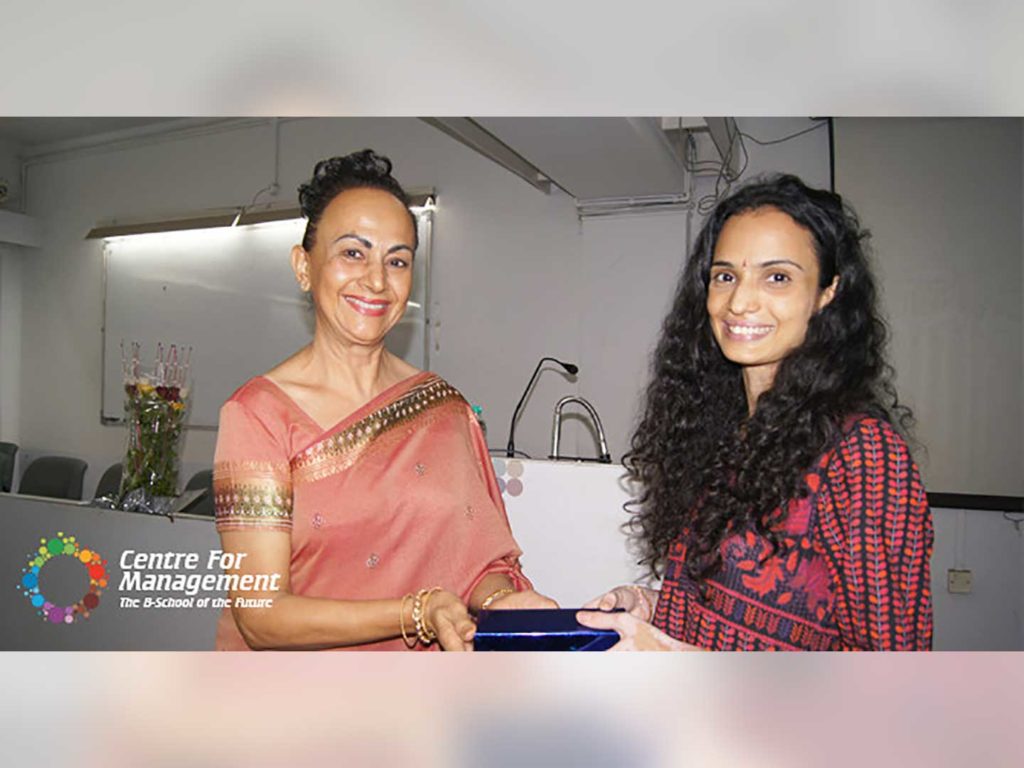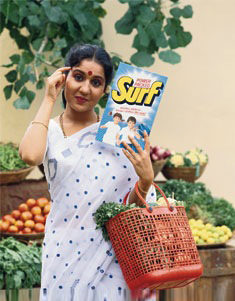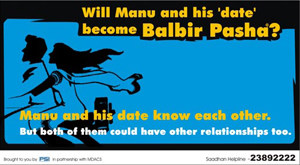Search
Exploring the History of Indian Advertising with Karishma Birdy, Business Development Director, Lowe Lintas and Partners
October 28, 2013

However, before the guest speaker took the dias, Maya Shahani, Chairperson, Thadomal Shahani Centre for Management, introduced Karishma and emphasized the importance of brand-building today, not just for companies but also individuals. Giving the examples of public figures such as Narendra Modi and Kumar Mangalam Birla, Mrs. Shahani pointed out that even the tiniest bit of negative publicity can bring down the biggest of brands.
Karishma began by asking the students to name a brand that personified them best. Jeffrey Saxena said Lamborghini was what came to his mind because the brand is all about innovation. Vijyendra Parthasarthy named Louis Vuitton because of its tag of exclusivity and high standards of quality, while Sachin Tendulkar was Kunal Khatwani’s brand of choice.
Before zeroing in on India, Karishma briefly told students about the origins of advertising. Did you know that the first ever print advertisement was created in 1472 for the sale of a prayer book in an English handbook?! And that B Palmers was the first advertising agency that was established in 1841 in Philadelphia, United States?
 Karishma told students that Indian advertising began in 1883, but it was only in 1939 that the first brand and marketing campaign – the kind we are familiar with today – took off. The campaign centered around Dalda – a brand of hydrogenated vegetable oil that has become synonymous with the oil itself – and was launched by Lintas. Also, it was in these initial years that advertising sought to appeal to traditional Indian sentiments. For example, Burmah Shell (now BPCL) made use of mythological art to connect with the Indian consumer.
Karishma told students that Indian advertising began in 1883, but it was only in 1939 that the first brand and marketing campaign – the kind we are familiar with today – took off. The campaign centered around Dalda – a brand of hydrogenated vegetable oil that has become synonymous with the oil itself – and was launched by Lintas. Also, it was in these initial years that advertising sought to appeal to traditional Indian sentiments. For example, Burmah Shell (now BPCL) made use of mythological art to connect with the Indian consumer.
Karishma says she is particularly interested in the Sabun or Soap story in Indian advertising which began from the 1950s onwards. “The Indian housewife is always busy. The only time she gets some respite and some privacy is while taking a bath. It is here that she escapes into a world of her own,” said Karishma, adding that soap brands have been appealing to this part of the female mindscape for decades. While the Liril girl symbolizes liberation and freedom, Lux has positioned itself as ‘the beauty soap of the stars’.
Then there was Lifebuoy which has managed to become the world’s largest-selling health soap. “Lifebuoy is a complete strategy brand. From initially being positioned as a soap for men it is today marketed as a family soap,” Karishma noted.

By the 1980s, advertising found itself in the age of aspiration. Karishma stated, “The 80s got consumers to open up their minds and purse strings.” For example, to counteract the detrimental effect on the economically priced Nirma soap powder on its sales, Lowe Lintas devised a brilliant strategy for Surf – ‘Lalitaji’, an independent, value-conscious housewife who is never willing to compromise on quality, even if it comes at a higher price. This was also the decade that saw some brilliant campaigns from brands like Maggi, Onida, Lakme, Kamasutra and Bajaj, among many others.
The 90s ushered in a complete transformation in advertising – global agencies entered India, a country which had just opened its doors to the consumer economy. International brands vied for the attention of buyers and ad agencies had to get creative to get their message across. The historic Pepsi-Coca Cola war played out on Indian soil. Both the cola giants locked horns over securing a prime position in the market as TV campaigns and print ads were heavily deployed to win over the Indian consumer. Meanwhile, Fevicol broke the mould of advertising that listed the advantages of the product by creating ads where the product wasn’t even displayed or mentioned!
 Finally, from 2000 onwards, the move has gradually shifted from being smart & sassy just for the heck of it ( ‘the era of being bindaas’) to becoming more socially conscious and aware of one’s presence in the collective whole of society. The Balbir Pasha campaign against AIDS – created by Lowe Lintas – which started in 2003. perhaps best exemplifies this shift.
Finally, from 2000 onwards, the move has gradually shifted from being smart & sassy just for the heck of it ( ‘the era of being bindaas’) to becoming more socially conscious and aware of one’s presence in the collective whole of society. The Balbir Pasha campaign against AIDS – created by Lowe Lintas – which started in 2003. perhaps best exemplifies this shift.
First-year PGDBM students picked up several advertising trivia gems all through the session and absolutely enjoyed watching some old TVCs that Karishma had brought along with her. It was a very enlightening session and the students hope to see Karishma back again very soon!
Important Links:
- Post Graduate Diploma in Digital Marketing: https://ask.careers/courses/post-graduate-diploma-in-digital-business/
- Post Graduate Diploma in Integrated Marketing, Advertising & Communication: https://ask.careers/courses/post-graduate-diploma-in-advertising-marketing/
- Professional Diploma in Digital Marketing: https://ask.careers/courses/professional-diploma-in-digital-marketing/
- Mumbai: https://ask.careers/cities/mumbai/
- Lonavala: https://ask.careers/cities/lonavala/
- TSCMC: https://ask.careers/?post_type=institute&p=401419



